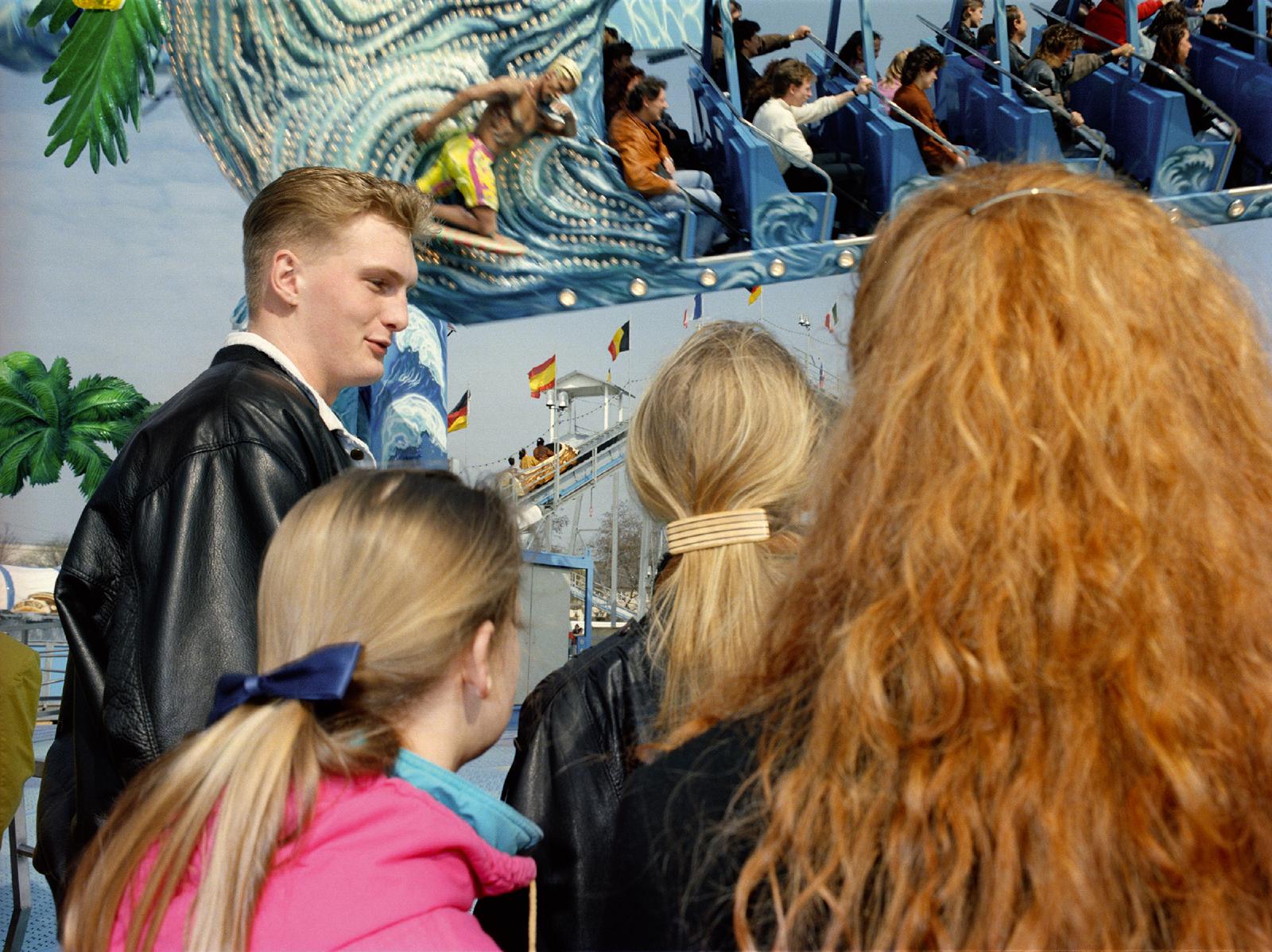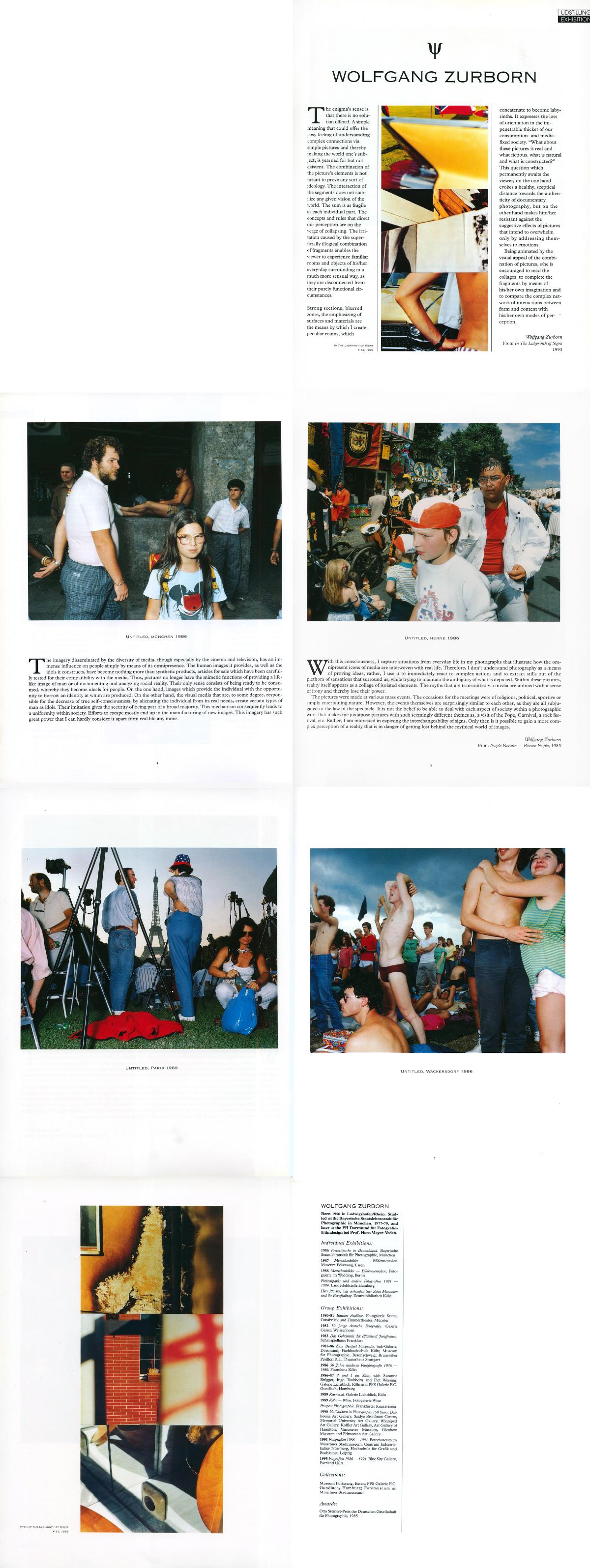People Pictures – Picture People
For the realization of the photographic project “Menschenbilder - Bildermenschen” Wolfgang Zurborn received the Otto-Steinert-Scholarship of the German Society for Photography (DGPh) in 1985.
Excerpt from the concept for the series:
The world of images, disseminated by the various media, but especially by film and television, exerts a tremendous influence on human beings through the omnipresence with which it encounters us in everyday life. The images of people that it spreads, the idols that it builds up, are mostly only synthetic products, a commodity that has been tested for its media effectiveness. Images no longer have the
that, for me, it can hardly be seen separately from real life, as it affects our subconscious to such an extent that it exists for us more than reality itself. With this awareness, I capture situations of everyday life in my photographs that illustrate the intertwining of the media’s everyday imagery with our real lives.
The photographs created during the fellowship were first shown in 1987 at the Museum Folkwang in Essen, and were subsequently presented in several international exhibitions: in 1993 at the Blue Sky Gallery in Portland, USA, and in 1994 in Odense and Copenhagen-Hellerup, Denmark.
| Solo exhibitions | ||
|---|---|---|
| 1997 |
ART NTC Doppelausstellung Wolfgang Zurborn - Fotografische Arbeiten, Justus Mandelaub - Gemälde Neurologisches Therapiezentrum, Köln, Germany |
|
| 1994 |
Fotografien 1986-1993 Gentofte Hovedbibliotek, Copenhagen-Hellerup, Denmark |
|
| 1994 |
Fotografien 1986-1993 Museet for Fotokunst, Odense, Denmark |
|
| 1993 |
Fotografien 1986-1991 Blue Sky Gallery, Portland OR, United States |
|
| 1991 |
Fotografien 1986-1991 Hochschule für Grafik und Buchkunst, Leipzig, Germany (Katalog) |
|
| 1991 |
Fotografien 1986-1991 Fotomuseum im Münchner Stadtmuseum, München, Germany |
|
| 1991 |
Fotografien 1986-1991 Centrum Industriekultur, Nürnberg, Germany |
|
| 1988 |
Menschenbilder-Bildermenschen Fotogalerie im Wedding, Berlin, Germany |
|
| 1987 |
Menschenbilder-Bildermenschen Museum Folkwang, Essen, Germany |
|
| Group exhibitions | ||
|---|---|---|
| 2017 |
Um ein Haar mit Stefanie Minzenmay Studio Bronx, Neuss, Germany |
|
| 1998 |
Otto-Steinert-Preisträger Meeting Point der DGPh, Int. Photoszene Köln, Germany |
|
| 1997 |
Otto Steinert - Preisträger Ausstellung mit Arbeiten von Hermann Stamm, Heiner Blum, Thomas Deutschmann, Jürgen Hocke/Gabi Winkler, Andreas Horlitz, Holger Stumpf, Thomas Bernd, Wolfgang Zurborn, Ulrich Görlich, Stefan Dolfen, Gerard Saitner, Jitka Hanzlova und Arwed Messmer Fototage Herten, Germany |
|
|
1990- 1992 |
Children in Photography 150 Years Dalhousie Art Gallery Saidye Bronfman Centre, Memorial University Art Gallery, Winnipeg Art Gallery, Koffler Art Gallery, Art Gallery of Hamilton, Vancouver Museum, Glenbow Museum und Edmonton Art Gallery, United States (Katalog) |
|
| 1989 |
Karneval Galerie Lichtblick, Köln, Germany |
|
| 1989 |
Prospect Photographie Ausstellung u.a. mit Richard Avedon, John Baldessari, Bernhard Johannes Blume, Christian Boltanski, Bernhard Faucon, Alfredo Jarr, Ken Lum, Sally Mann, Robert Mapplethorpe, Duane Michals, Thomas Struth, Wim Wenders, Joel Peter Witkin und Wolfgang Zurborn Frankfurter Kunstverein, Frankurt, Germany (Katalog) |
|
| 1989 |
Köln-Wien Ausstellung mit Arbeiten von Rosy Beyelschmidt, Gerd Bonfert, Susanne Brügger, Michael Hooymann, Ralf Kietz, Roger Lips. Josef Scherrer, Josef Snobl, Ulrich Tillmann und Wolfgang Zurborn Fotogalerie Wien, Austria (Katalog) |
|
| 1987 |
3 und 1 im Sinn mit Susanne Brügger, Ingo Taubhorn und Piet Wessing PPS. Galerie F.C. Gundlach, Hamburg, Germany |
|
| 1986 |
3 und 1 im Sinn mit Susanne Brügger, Ingo Taubhorn und Piet Wessing Galerie Lichtblick, Köln, Germany |
|
| 1986 |
50 Jahre moderne Farbfotografie 1936-1986 Photokina, Köln, Germany (Katalog) |
|
Reviews
Wolfgang Zurborn
by Niko Havranek & Sebastian Gansrigler
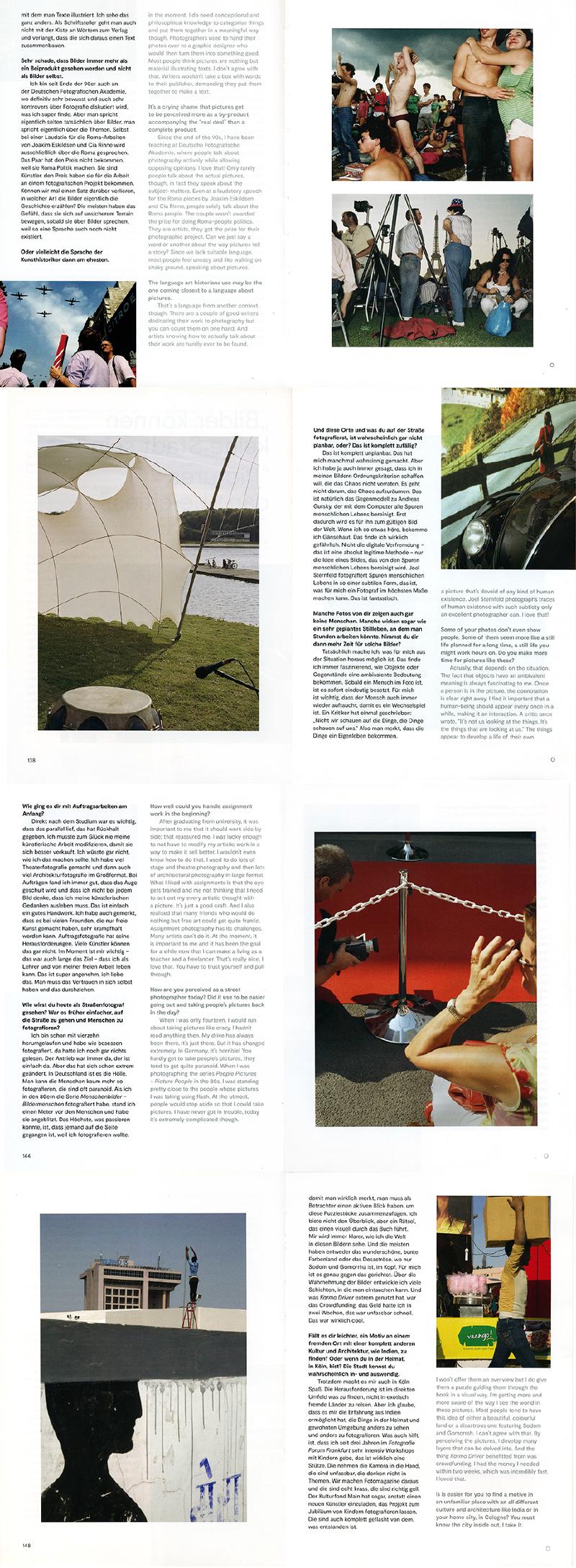
Interview by Niko Havranek & Sebastian Gansrigler with Wolfgang Zurborn on 28 pages with 24 images from the series “Frontgarden of Illusios”, “People Pictures - Picture People”, “LUsionen”, “dressur real”, “At the Centre of Speed”, " Drift", “Catch”, “In the Middle of the West” and “Karma Driver”
Urban shots zoom in on claustrophobia
by Gretchen Matis
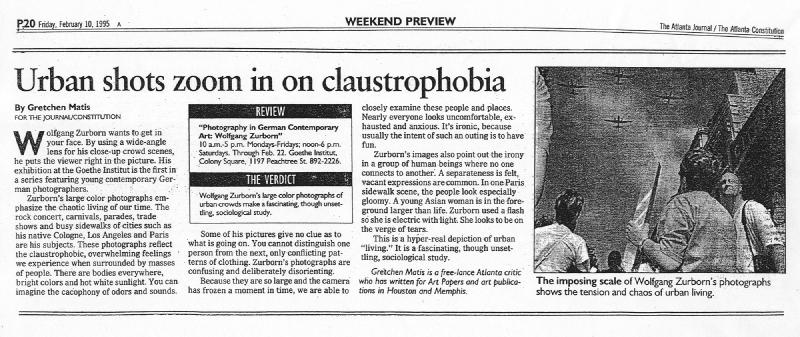
The Verdict: Wolfgang Zurborn’s large color photographs of urban crowds make a fascinating, though unsettling, sociological study.
Wolfgang Zurborn wants to get in your face. By using a wide-angle lens for his close-up crowd scenes, he puts the viewer right in the picture. His exhibition at the Goethe Institut is the first in a series featuring young contemporary German photographers.
Zurborn’s large color photographs emphasize the chaotic living of our time. The rock concert, carnivals, parades, trade shows and busy sidewalks of cities such as his native Cologne, Los Angeles and Paris are his subjects. These photographs reflect the claustrophobic, overwhelming feelings we experience when surrounded by masses of people. There are bodies everywhere, bright colors and hot white sunlight. You can imagine the cacophony of odors and sounds.
Some of his pictures give no clue as to what is going on. You cannot distinguish one person from the next, only conflicting patterns of clothing. Zurborn’s photographs are confusing and deliberately disorienting. Because they are so large and the camera has frozen a moment in time, we are able to closely examine these people and places. Nearly everyone looks uncomfortable, exhausted and anxious. It’s ironic, because usually the intent of such an outing is to have fun.
Zurborn’s images also point out the irony in a group of human beings where no one connects to another. Separateness is felt, vacant expressions are common. In one Paris sidewalk scene, the people look especially gloomy. A young Asian woman is in the foreground larger than life. Zurborn used a flash so she is electric with light. She looks to be on the verge of tears.
This is a hyper-real depiction of urban “living”. It is a fascinating, though unsettling, sociological study.
People Pictures – Picture People
by Jan Thorn Prikker
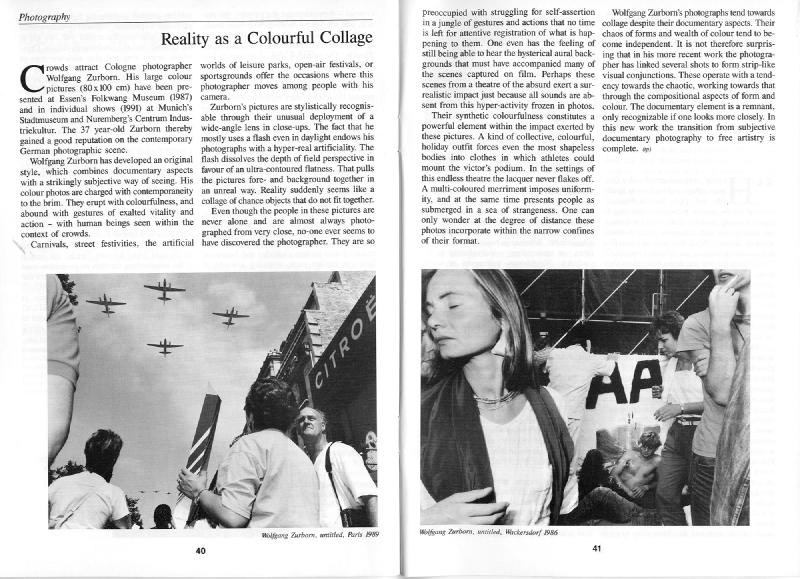
Crowds attract Cologne photographer Wolfgang Zurborn. His large colour pictures (80x100 cm) have been presented at Essen’s Folkwang Museum (1987) and in individual shows (1991) at Munich’s Stadtmuseum and Nuremberg’s Centrum Industriekultur. The 37 year-old Zurborn thereby gained a good reputation on the contemporary German photographic scene.
Wolfgang Zurborn has developed an original style, which combines documentary aspects with a strikingly subjective way of seeing. His colour photos are charged with contemporaneity to the brim. They erupt with colourfulness, and abound with gestures of exalted vitality and action – with human beings seen within the context of crowds. Carnivals, street festivities, the artificial worlds of leisure parks, open-air festivals, or sportsgrounds offer the occasions where this photographer moves among people with his camera.
Zurborn’s pictures are stylistically recognisable through their unusual deployment of a wide-angle lens in close-ups. The fact that he mostly uses a flash even in daylight endows his photographs with a hyper-real artificiality. The flash dissolves the depth of field perspective in favour of an ultra-contoured flatness. That pulls the pictures fore- and background together in an unreal way. Reality suddenly seems like a collage of chance objects that do not fit together.
Even though the people in these pictures are never alone and are almost always photographed from very close, no-one ever seems to have discovered the photographer. They are so preoccupied with struggling for self assertion in a jungle of gestures and actions that no time is left for attentive registration of what is happening to them. One even has the feeling of still being able to hear the hysterical aural backgrounds that must have accompanied many of the scenes captured on film. Perhaps these scenes from a theatre of the absurd exert a surrealistic impact just because all sounds are absent from this hyper-activity frozen in photos.
Their synthetic colourfulness constitutes a powerful element within the impact exerted by these pictures. A kind of collective, colourful, holiday outfit forces even the most shapeless bodies into clothes in which athletes could mount the victor’s podium. In the settings of this endless theatre the lacquer never flakes off. A multi-coloured merriment imposes uniformity, and at the same time presents people as submerged in a sea of strangeness. One can only wonder at the degree of distance these photos incorporate within the narrow confines of their format.
Wolfgang Zurborn’s photographs tend towards collage despite their documentary aspects. Their chaos of forms and wealth of colour tend to become independent. It is not therefore surprising that that in his more recent work the photographer has linked several shots to form stripe-like visual conjunctions. These operate with a tendency towards the chaotic, working towards that trough the compositional aspects of form and colour. The documentary element is a remnant, only recognisable if one look more closely. In this new work the transition from subjective documentary photography to free artistry is complete.
